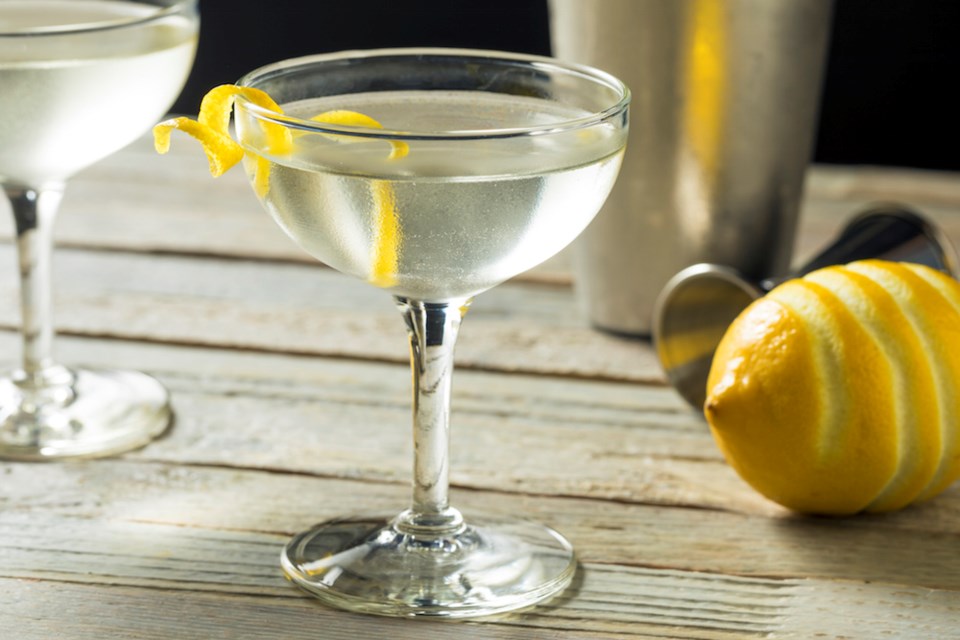Plenty a tall tale has crossed the polished oak; after all, bartenders like to dish out lively anecdotes along with the gin and spiced nuts. But when it comes to boozy myths, legends, outright lies and wholesale whoppers, “more cling to the Martini than any other cocktail.”
So writes Robert Simonson in his IACP-nominated book The Martini Cocktail (Ten Speed Press). He is fascinated by the outsize role the Martini has played in popular culture ever since its invention in 1849, or maybe it was the 1880s, or possibly 1906, who knows?
Whenever that first barkeep stirred, or shook, or threw that first Martini, he (and it was almost certainly a he) changed the course of drinking history. No other cocktail has gripped the public imagination so firmly and for so long. Even when the Martini fell out of fashion in the 1970s—too bourgeois for the right-on set—mournful essays were penned to its demise.
The Martini has always been enjoyed by elites, intellectuals and sophisticates. It is also enjoyed by the masses, an impressive crossing of cultural and class boundaries. “The drink didn’t stumble into this reputation,” writes an admiring Simonson. “It seems to have worn it from the very first.”
That “first” is where things get as murky as a Dirty Martini.
Some trace it back to a cocktail called the Martinez that was allegedly invented in a California Gold Rush town called Martinez in the mid-1800s. Others say Jerry Thomas—the great-grandfather of modern mixology—invented an early version of the Martini in the 1860s. Still others believe a bartender named Martini di Arma di Taggia served the first versions of the botanical-bright drink around 1906 at New York City’s Knickerbocker Hotel. Or maybe the drink was simply named for Martini & Rossi vermouth.
“The boring but most likely story of the birth of the Martini is that a cocktail made of gin and vermouth probably evolved naturally in multiple bars in multiple locations around the same time, once those premises came into possession of vermouth and a barman with a modicum of imagination,” Simonson writes, a little crushingly.
In any case, recipes for both the Martini and Martinez started appearing in the 1880s, though the early Martinis were much sweeter, calling for Old Tom gin, various liqueurs and gum syrup, as well as bitters and vermouth; the “dry” version we know only dates back to the 1920s or ’30s.
Until then, the Martini had been paired in popularity with the whisky-based Manhattan, but access to bathtub gin during the dusty years of Prohibition elevated the Martini’s supremacy. Then in 1934, mere months after repeal, came a gin-soaked movie that ensured it. The first time we see William Powell as Nick Charles in The Thin Man, he’s shaking up a batch of Martinis.
“The important thing is the rhythm,” he says, cobbler in hand. “Always have rhythm in your shaking. Now a Manhattan you always shake to fox-trot time, a Bronx to two-step time, a dry Martini you always shake to waltz time.”
Of course, we all know that a Martini should always be stirred, not shaken. (“Bruises the gin,” Auntie Mame would say.) But that is just about all we know about the Martini, except that we would very much like one right about now.
Shaken or stirred?
The most famous Martini aficionado is, of course, James Bond, the suave spy created by author Ian Fleming. Although Bond is best known for ordering vodka Martinis “shaken, not stirred,” in the books he was actually more likely to drink Champagne or scotch-and-soda highballs. The first mention of a Martini is in Casino Royale, and would come to be known as the Vesper.
Martini Variations
- Vodka Martini (aka Kangaroo): Replace gin with vodka.
- Gibson: Garnish with two pickled onions instead of the lemon or olive.
- Dirty: Add a splash of olive brine before stirring with ice.
- Perfect Martini: Use equal parts sweet and dry vermouth.
- Burnt Martini: Rinse the glass with a peated scotch first.
- Churchill Martini (aka Desert Martini): Wave the vermouth in the general direction
- of the mixing glass, but don’t actually add it to the drink.
Make these classic cocktails at home:
Read more from The Alchemist



